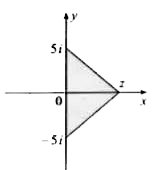The complex number z which satisfies the condition ∣∣∣i+zi−z∣∣∣=1 lies on
a) Circle x^(2) + y^(2) =1
b) The x axis
c) The y-axis
d) The line x+y=1
The correct Answer is:B
To solve the problem, we need to find the complex number z that satisfies the condition
∣∣∣i+zi−z∣∣∣=1.
Step 1: Understanding the Condition
The condition ∣∣∣i+zi−z∣∣∣=1 implies that the magnitudes of the numerator and denominator are equal. Thus, we can rewrite the condition as:
|i+z|=|i−z|.
Step 2: Express z in terms of its Real and Imaginary Parts
Let z=x+iy, where x and y are real numbers. Substituting z into the equation gives:
|i+(x+iy)|=|i−(x+iy)|.
This simplifies to:
|x+(1+y)i|=|−x+(1−y)i|.
Step 3: Calculate the Magnitudes
Now we calculate the magnitudes on both sides:
1. For the left side:
|x+(1+y)i|=√x2+(1+y)2.
2. For the right side:
|−x+(1−y)i|=√(−x)2+(1−y)2=√x2+(1−y)2.
Step 4: Set the Magnitudes Equal
Setting the two magnitudes equal gives:
√x2+(1+y)2=√x2+(1−y)2.
Step 5: Square Both Sides
To eliminate the square roots, we square both sides:
x2+(1+y)2=x2+(1−y)2.
Step 6: Simplify the Equation
Cancel x2 from both sides:
(1+y)2=(1−y)2.
Expanding both sides results in:
1+2y+y2=1−2y+y2.
Step 7: Solve for y
Subtract y2 and 1 from both sides:
2y=−2y.
Adding 2y to both sides gives:
4y=0⟹y=0.
Step 8: Conclusion
Since y=0, the complex number z lies on the real axis, which means z=x+0i=x where x is any real number.
Thus, the complex number z that satisfies the given condition lies on the x-axis.
Final Answer
The complex number z lies on the x-axis.
---
The condition ∣∣∣i+zi−z∣∣∣=1 implies that the magnitudes of the numerator and denominator are equal. Thus, we can rewrite the condition as:
Let z=x+iy, where x and y are real numbers. Substituting z into the equation gives:
Now we calculate the magnitudes on both sides:
Setting the two magnitudes equal gives:
To eliminate the square roots, we square both sides:
Cancel x2 from both sides:
Subtract y2 and 1 from both sides:
Since y=0, the complex number z lies on the real axis, which means z=x+0i=x where x is any real number.
The complex number z lies on the x-axis.
Topper's Solved these Questions
Similar Questions
Knowledge Check
The complex number z =x+iy which satisfies the equation ∣∣∣z−3iz+3i∣∣∣=1, then on
Athe X-axisBthe straight line y = 3Ca circle passing through originDNone of the aboveThe complex number z =x+iy which satisfies the equation ∣∣∣z−3iz+3i∣∣∣=1, then on
Athe X-axisBthe straight line y = 3Ca circle passing through originDNone of the aboveThe complex numbers z = x + iy which satisfy the equation ∣∣∣z−5iz+5i∣∣∣=1, lie on
 Athe x - axisBthe straight line y = 5Ca circle passing through originDNone of these
Athe x - axisBthe straight line y = 5Ca circle passing through originDNone of these
If the complex number z satisfies the condition |z|≥3, then the least value of ∣∣∣z+1z∣∣∣ is equal to
View SolutionThe complex number z satisfying the equation |z−i|=|z+1|=1
View SolutionFind a complex number z satisfying the equation z+√2|z+1|+i=0.
View SolutionThe complex numbers z = x + iy which satisfy the equation ∣∣∣z−5iz+5i∣∣∣=1, lie on

View SolutionFor the complex number z satisfying the condition ∣∣∣z+2z∣∣∣=2, the maximum value of |z| is
View Solution